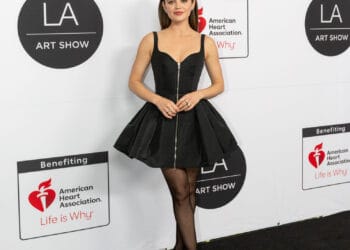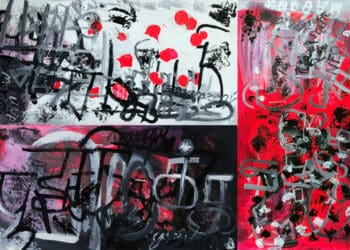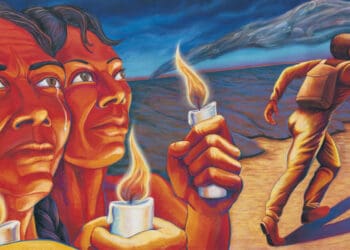Art Stars don’t happen often. Pablo Picasso and Salvador Dali certainly were one. Andy Warhol of course, came along and took it to a new level. Yeah Yeah Yeahs wrote a song about it. But today, there are few. Jean Michel-Basquiat, Keith Haring, and David Wojnarowicz certainly were one. The art world never again saw another like them. Sure, there is Banksy. But like the band the Residents who cover their faces with giant eyeballs, he never shows who he is. Richard Prince could have been one. But tell me, can you even recall what Richard Prince looks like? Me neither. And then we are stuck with Damien Hirst. Again too, we can remember some of his artworks, but not the man himself. But thankfully, that all is about to change. Meet Lorenzo Marini.
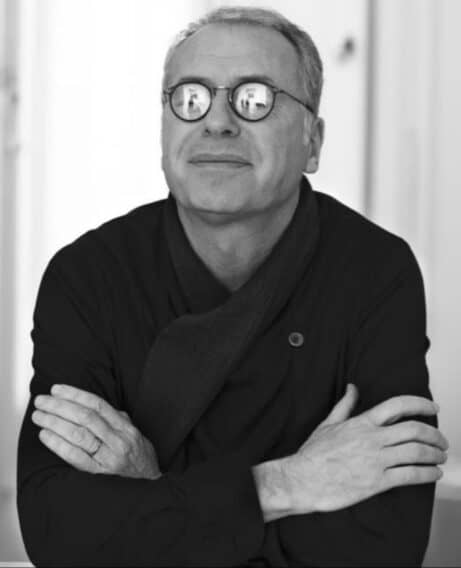
His name alone sounds exotic, like the world famous designer of a fine Italian suit a man would wear to the Met Gala, or the founder of an overpriced sportscar that goes faster than you need to go. In reality, he’s neither of these.
Ralph Waldo Emerson once wrote, “Monselice is the most picturesque town I have seen in Italy. It has an old ruin of a castle upon the hill and thence commands a beautiful and extraordinary view. It lies in the wide plain – a dead level – whereon Ferrara, Bologna, Rovigo, Este, Padua stand and even Venice we could dimly see in the horizon rising with her tiara of proud towers. What a walk and what a wide delightful picture. To Venice 38 miles.”
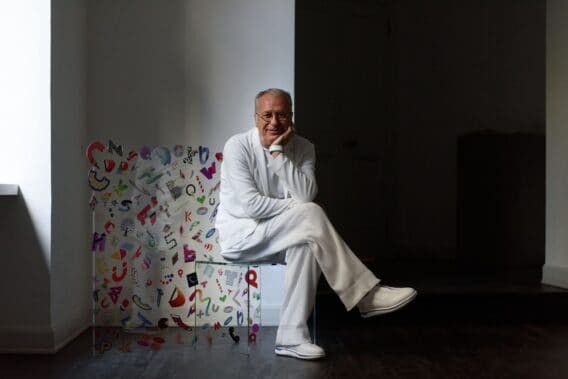
It was here in Monselice that Lorenzo Marini was born. Just a few hours drive from the birthplace of Leonardo Davinci, and even closer to where Federico Fellini began, Marini grew up in the stomping grounds of some of the greatest Masters of Fine Art of all time; Michelangelo, Bellini, Modigliani, Manzoni, and countless more legends of the Italian Renaissance undoubtedly influenced the young artists aesthetic taste for quality, excellence, and class, growing up.
Finishing his degree in architecture in Venice in 1980, Marini worked with a number of Italian advertising agencies including the world famous Ogilvy, Leo Burnett, Canard and Gruppo Armando Testa. Wanting more freedom however, he launched his own agency; Lorenzo Marini & Associati in Milan in 1997. The company skyrocketed, and so a new branch in Turin was also created. Still not enough however, and unable to keep up with business booming from America, he expanded yet again, opening another office in in New York.
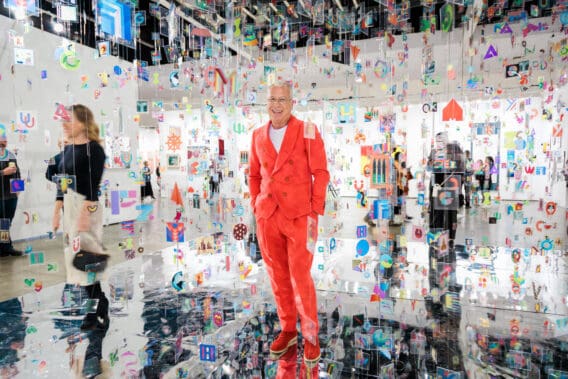
Business was phenomenal, and the awards he gained as an art director were more than plentiful. Marini has received over 500 awards in Italy and internationally, including the Lion d’Or at the Cannes International Advertising Festival for his campaign for Agnesi pasta in 1985. A multidisciplinary artist, over the years Marini has made inroads in many branches of the arts: drawing cartoons, directing, painting, and particularly writing, with the publication of several works of non-fiction and two novels, one of which has been translated into English.
For Italy’s RAI 2 radio station, he has presented “Il giorno della marmotta” (“Groundhog Day”), a program about creativity, together with Dario Vergassola.
Of notable importance, is Marini’s philosophy of bringing the color palette back into painting, and particularly, lettering. “My job is to be happy,” he says. “Any time you ask me how I am doing, I will always answer the same–happy!” He adds, I am tired of all of this depressing black and gray in painting. All of this sadness. Who wants to be sad?! No! People want to be happy! They want to be cheerful. I like color!” And evidently, so do his hundreds of thousands of new art fans, and collectors around the world.
Marini’s art career was mentored by Emilio Vedova, after completing his degree in architecture from the University of Venice. Only in 2010 did Marini begin exhibiting his artworks to the public. The first exhibitions were held in New York and Miami, and he also participated at Art Basel Miami. In 2016 at the Palazzo della Permanente in Milan he unveiled “Type Art,” a movement of which Marini is the founder and which in 2017 he exhibited at the 57th Biennale Arte in Venice (at the Armenia Pavilion).
In 2017 Marini was conferred with the Pubblicità nell’Arte award, an award introduced at the 11th NC Awards.
Marini has created the logo and branding for Lavazza Espression, Galleria Borghese, Conai, Lux Vide, Fastweb, Novamont, Spuma Di Sciampagna, Eicma, Oltremare, Faac, Agnesi, and Zucchi, among others.
Since 2019 he has collaborated with Cramum and Sabino Maria Frassà: the AlphaCUBE installation presented for DesignWeek 2019 (by Ventura Projects) was exhibited in Venice (for the 58th Biennale Arte), Dubai and finally in Los Angeles.
In 2020 in Los Angeles, Marini received the Mobius Advertising Award in an international competition for creativity, for the new alphabet of his creation, Futurtype.
In the same year, he presented his new cycle of works titled “Typemoticon” for his personal exhibition “Out of Words” at Gaggenau Hub in Milan.
In September 2020 he designed the “Manifesto for the Venice Pavilion” at the Venice Biennale, titled Aperture Straordinarie (“Extraordinary Openings”).
In 2020, at the end of the lockdown period in Italy, artistic events culminated once again in the main cities of Italy with dynamic and static installations, welcoming residents, and workers back to those cities. In these installations, Marini’s liberated alphabets are a metaphor for people coming together once again.
In 2021 Marini received the AVI award for the most visited exhibition in Italy of contemporary art, Di Segni e Di Sogni (“Of Signs and of Dreams”), at the Santa Maria della Scala museum complex in Siena, with over 50,000 visitors.
TypeArt is an art movement founded by Marini that celebrates the aesthetic beauty of letters.
Lorenzo Marini: Artist Biography
“Letters are born free, just as humans are social creatures but also individuals.”
Guided by a singular quest-to liberate the alphabet from the ubiquitous demands and functional limitations of language-the work of Italian artist Lorenzo Marini (b. 1958, Padova, Italy) openly charms yet subtly disarms the viewer through his wryly subversive process of “semantic delocalization.” A graduate, in 1980, of the University of Venice, in the field of architecture, The notable Marini System emanated while employed at powerhouse international advertising agencies Ogilvy, Leo Burnett, Canard, and Gruppo Armando Testa, before launching the eponymous Lorenzo Marini & Associati in 1997. A devotee to the world of design, Marini coined the term “Type Art” in 2016 to categorize his oeuvre, in which letters “have dignity equal to that of portraits, landscapes, still life, and abstract works.”
Marini’s whimsical crusade, from the early nineties until 2014, was a tightly held secret. Marini mastered the craft of commercially-driven visual communication, designed to drive consumers to purchase goods and services. During those years he attracted major brands as clients and created an empire with Marini & Associati, founding offices in Milan, Turin, and New York. Yet he simultaneously pursued art for art’s sake, in isolation. Many works of that emergent period feature images of receding Latin and Roman derived fonts suffused with cloud-like tufts of painterly white. Earlier canvases from the Spacevisual and Advisual series whisper of minimalism, quiet, and restraint. Echoes of Twombly form an almost sonic halo around the inherited traits of Pop Art-the parallels between Marini’s and Warhol’s professional trajectories are all too obvious-the grid, the precision of draftsmanship, the history of typesetting itself in relation to the explosion of buying and selling in the post-war, high Modern economy. The materials themselves: mother-of-pearl, chalk, pencil, graphite, silver leaf, plexiglass, and acrylic and oil paints reference craftsmanship, the design blueprints and swatch boards of industrial engineering, and art high and low.
Marini made his first public appearances as an artist in Miami and New York in 2014, followed by a presentation of two decades of work organized by the Province of Milan. From that point forward Marini has exhibited extensively in museums, galleries, and at art fairs in Europe, the United States, and Dubai, garnering prizes, and critical acclaim along the way.
In his two-dimensional work, Marini explores the warp and weft of language/semiotics, nature/culture, and representation/abstraction, evoking the cycles of day to night, rain to snow, form to function, and order to chaos. In the TypeVisual series from 2016-2019, streams of scrawled free associations (Tomato, Tarzan, Tsunami … ) juxtaposed alongside fragments of mark-making signage (Is it a prism? A W? A V?) recall the collaborations of Warhol and Basquiat. With his 2018-2019 series AlphaType, the hidden alphabet is obscured by extremes of light and darkness. The visible alphabet destroys “meaning” through randomized reorganization and maximalist color. The language of paint itself competes in bright drizzles and drips, but there’s always a fusion of synthesis and antithesis. In 2019’s FuturType there are areas of stylized chiaroscuro that take the cold-chiseled polish of Art Deco artist Tamara de Lempicka and exchange her fascination with flesh with Marini’s fascination for A, S, D, M, and wing dings.
In installations in museums (TypeVisual, 2016), on digital screens (SnowType, 2020), train cars (DynamicType, 2020), art fairs (AlphaCube, 2019; RainType, 2023), and 3D sculptural works (3D Type, 2017; 3D Alphabet, 2018) the liberation of the alphabet progresses to include autonomy from the picture plane as letters cycle from stasis to dynamism.
Meet and Greet with the Artist Lorenzo Marini tomorrow Sunday, 19 February, 2023, between 12noon and 6pm on the final day of the LA Art show. Visit:
Bruce Lurie Gallery | Booth 1312 & 1315 & Citi space
LOS ANGELES CONVENTION CENTER – WEST HALL
1201 South Figueroa Street Los Angeles, CA 90015
Press media for the artist Lorenzo Marini, contact 310-226-7176
https://lorenzomariniarte.com/en/
Works consulted: Wikipedia, Artillery



